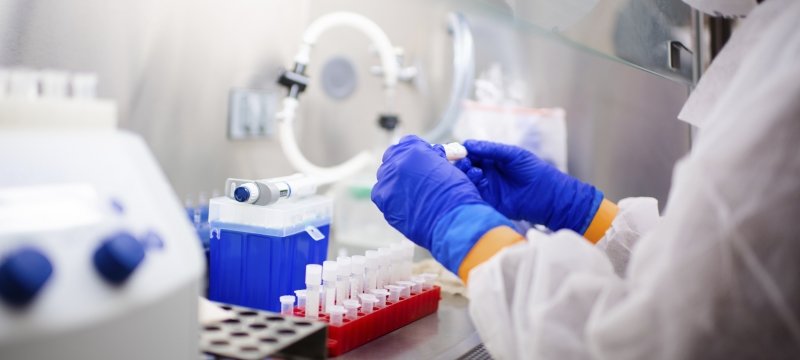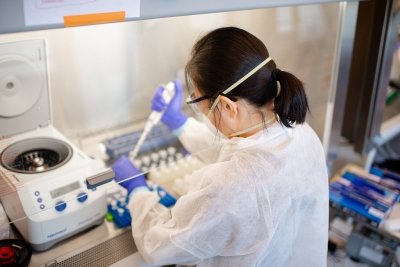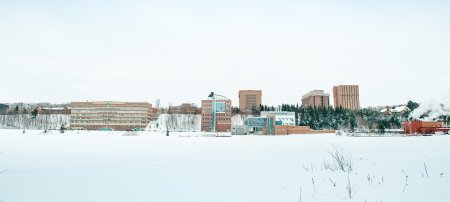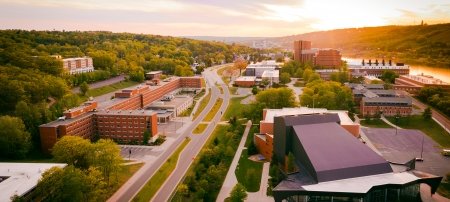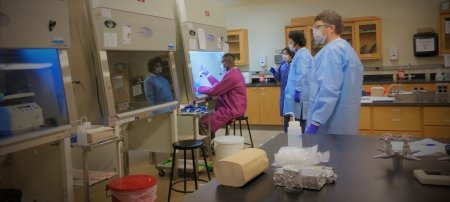When SARS-CoV-2, the virus that causes COVID-19, began to spread through the US in spring 2020, Michigan Tech got to work in the Upper Peninsula and across the globe.
Just weeks after the World Health Organization (WHO) declared COVID-19 to be a pandemic, COVID-19 testing in the UP was limited. Not everyone could get a test, and those who could had samples sent to downstate labs. The results were often delayed, whether by travel times or testing backlogs.
Fast forward a year. The Michigan Tech COVID-19 Testing Lab performed more than 30,000 tests between April 2020 and February 2021. The University's testing plan has been recognized as one of the most comprehensive in the nation. Through individual and group contributions, our students and staff have joined the worldwide effort to halt the spread of the SARS-CoV-2 virus.
"Helping to create the COVID testing lab at Michigan Tech has been the most meaningful thing I have accomplished in my career. It was also the hardest. We had so much to learn to run a regulated medical lab from the ground up. It took us three weeks from conception to opening our doors and we just kept pushing, even when we ran into roadblocks, from procurement to technical issues."
Research made it possible. And our research continues into 2021, rooted in ingenuity, scientific expertise, and the interdisciplinary efforts of our extraordinary researchers.
As Caryn Heldt, director of the Health Research Institute and professor of chemical engineering, puts it: “Everyone jumped in to help. We would ask IT or Facilities to help and it happened almost instantly. The impact this lab has had on our community and on the University has been tremendous. When Huskies put their mind to something, we cannot be stopped!”
"Beyond providing the rapid and sensitive testing that is important for managing the spread of COVID, the testing laboratory represents the amazing things people can do when they work together. People with ideas, knowledge, and experience, from literally around the world, came together and we worked to make a difference in our community."
COVID-19 Testing Lab
Last spring, Michigan Tech partnered with local hospitals to begin receiving and testing patient samples on campus to save doctors and health care providers the time of waiting for COVID-19 test results—which, at the beginning of the pandemic, often took up to two weeks.
The researchers who started the Michigan Tech COVID-19 Testing Lab include a medical doctor, a virologist, the University’s medical laboratory science clinical practicum coordinator, and a chemical engineer specializing in vaccine development, as well as plant and wildlife geneticists, microbiologists, and biomedical engineers.
"Many clinical labs in the area were sending specimens to reference labs to keep up with testing needs. It would often take a week to get test results back to the patient. With the Michigan Tech testing lab, we can provide test results within three days. The faster result turnaround time helps decrease the spread of COVID-19 to help save lives and get everyone a step closer to their normal life activities."
When it opened, the lab had the capacity to run 40 samples per hour on two machines. When students returned in August, the lab could process roughly 150 individual samples per day, or 500 pooled samples per day, with 98 percent of results coming back in 36 hours. And in early 2021, thanks to a gift from the Portage Health Foundation, the lab added equipment and software that enabled it to process nearly twice as many tests in half the time and with fewer personnel.
The gift included a KingFisher Flex System RNA extractor, which doubled testing capacity, and Orchard, a laboratory information system software, to streamline reporting of test results between the lab and the Upper Great Lakes Family Health Center.
The test to confirm a COVID-19 case has two parts and relies on finding the genetic fingerprint of SARS-CoV-2 among the skin cells, mucus, and microbes collected by a nasopharyngeal swab.
First, the genetic code needs to be pulled out of the samples; this is called RNA extraction. Then, using a thermocycler machine, the extracted sample is run through a polymerase chain reaction (PCR), considered the gold standard for COVID-19 testing. The PCR machine amplifies genetic code and makes it easier to find the coronavirus RNA fingerprint. Using specific chemicals, or reagents, the PCR machine produces a positive or negative result, depending on whether the virus’s RNA is present and how much is present.
With the testing lab established on campus, Michigan Tech created a comprehensive testing strategy for students. When students returned to campus in August 2020 and again in January 2021, they were asked to complete a baseline COVID-19 test once they arrived. The University is also conducting ongoing surveillance testing, in which a certain percentage of the student population (approximately 600 students per week) is tested to get a sense of whether COVID-19 infections are increasing or decreasing.
During baseline and surveillance testing, Michigan Tech student samples are pooled in groups of five. The University’s COVID-19 lab takes a portion from each of the five student samples, combines them to create a pool, and runs one PCR test on the pool. If the pool tests positive, the five samples are tested again individually.
Contact Tracing
To help contain the spread of COVID-19, both on campus and in the local community, Michigan Tech has recruited and trained a team of student volunteers who help the Western Upper Peninsula Health Department (WUPHD) by conducting contact tracing in our campus community. The team is led by Kelly Kamm, assistant professor of kinesiology and integrative physiology and the University’s epidemiologist.
"We don’t have a university health system, medical school, or school of public health. Yet our students stepped up to the challenge and volunteered to get trained in contact tracing to help contain the spread of COVID-19 in our campus community. We have a workforce of about a dozen student contact tracers who have been working since September, many of whom even worked during school breaks. Because of their effort, we are able to provide information about resources specific to our community and University to individuals in quarantine. We are also able to quickly notify our local health department if any of these individuals develop symptoms and become cases, which changes when they can safely be around others."
When someone tests positive for COVID-19, WUPHD calls and interviews them. The health department official asks about anyone the positive case might have been around during their infectious period to identify close contacts who need to quarantine. Michigan Tech contact tracers, all of whom are paid, work to notify these close contacts of the need to quarantine and help connect those in quarantine with University and community resources they may need.
Wastewater Testing
Wastewater monitoring on campus is a crucial component of Michigan Tech’s strategy for combating COVID-19. People generally begin shedding the virus in feces before they become symptomatic, and studies have shown that SARS-CoV-2 levels in wastewater predict the number of symptomatic individuals infected with COVID-19.
"We get a signal before people become symptomatic. Several studies, both in the US and elsewhere in the world, have shown [researchers] were able to predict outbreaks of the virus based on the signal in the wastewater. It gives us advance notice. It can help us determine where we need to direct resources, such as diagnostic COVID-19 testing or disseminating information about how to limit the spread of the illness."
Weekly monitoring of wastewater flows on campus reveals trends in the number of infections, even if infected individuals are asymptomatic. If SARS-CoV-2 levels increase in the wastewater stream generated by a particular residential building, University officials can increase diagnostic testing of the asymptomatic residents of that building to limit the spread of the virus among their contacts.
The team measures the virus in individual residence hall flows three times per week and in combined flow from multiple halls at regular intervals five times per week.
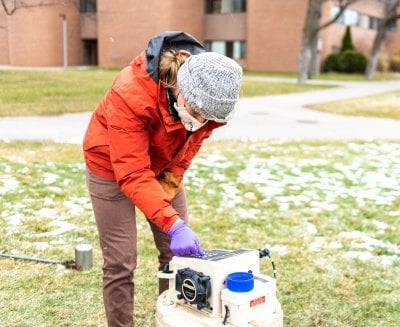
Jennifer Becker, associate professor of civil and environmental engineering, leads Michigan Tech’s wastewater monitoring efforts. The process Becker’s team uses to quantify the virus in wastewater has three main steps: concentrate the virus RNA, extract the virus RNA from the wastewater, and then quantify the amount of virus RNA in the samples using a technology known as reverse transcription-quantitative polymerase chain reaction (RT-qPCR).
In RT-qPCR, the virus RNA in a sample is converted to DNA, which is tagged with a fluorescent dye. The fluorescent DNA is then copied in repetitive cycles until the fluorescence can be reliably detected in the qPCR instrument. To measure the amount of virus in wastewater, the number of cycles required to generate a measurable signal can be used to estimate the abundance of the viral RNA (the process is repeated with solutions containing known concentrations of the viral RNA). Quantifying the amount of viral RNA goes a step further than diagnostic testing of human biospecimens, which also uses RT-qPCR but is primarily designed to determine only whether a sample is positive or negative for the virus.
In November 2020, the Michigan Department of Environment, Great Lakes, and Energy and the Michigan Department of Health and Human Services announced they were awarding $6 million in grant funding and $3 million in laboratory equipment to 20 teams across the state to support a three-month pilot program to assess the potential for using wastewater-based monitoring to assess COVID-19 dynamics in Michigan communities. Each team comprised a health department working in partnership with a laboratory and municipalities. A partnership between the WUPHD and Michigan Tech received $352,721 to quantify SARS-CoV-2 levels in samples collected by 18 municipalities throughout the five counties in the western Upper Peninsula of Michigan (Baraga, Gogebic, Houghton, Keweenaw, and Ontonagon). As part of this effort, Becker redirected her lab to process and analyze virus levels in approximately 70 samples per week using drop digital PCR instrumentation acquired through this initiative.
Air and Water
The States of Michigan and Ohio issued shelter-in-place orders in mid-March 2020 as the COVID-19 pandemic began to take hold in the US. With most residents of these states remaining at home, researchers Karl Bosse, Mike Sayers, and Bob Shuchman wondered whether the drop in activity would shift the typical drivers of water quality in the Great Lakes region. Specifically, they questioned:
- Whether potential changes in agriculture, ship traffic, and sewage outflows could impact the amount of sediment and nutrients entering the Great Lakes.
- Whether the lakes’ heat budget would be impacted by decreased carbon outputs from idle factories and reduced commuter traffic.
"Every day I work with people that redefine what is possible. So many of us are retooling skills from medical labs, scientific research, IT, engineering, and communications to build and operate an on-campus testing lab capable of running thousands of tests each week. It really shows you can do anything you put your mind to. I am so fortunate to see this firsthand each and every day while working with such a diverse team of people."
To answer these questions, scientists from the Michigan Tech Research Institute (MTRI) and NASA's Glenn Research Center are comparing data from 2020 to baseline data from 2012–2019 to determine if there are detectable anomalies in select water quality indicators that can be attributed to the pandemic. The water quality indicators will include chlorophyll-a concentration, total suspended sediments concentration, and how far light penetrates (as an indicator of water clarity).

Their analysis focuses on the western basin of Lake Erie and the Saginaw Bay of Lake Huron, two Great Lakes basins heavily impacted by human activity. Thunder Bay of Lake Huron will be used as a control site due to its comparably small human impact. The researchers are also investigating the aerosol optical thickness and lake surface temperature around major metropolitan areas, like Toledo, Ohio, and Bay City, Michigan, to determine if the decreased human activity is impacting the atmosphere or water temperature around population centers. They’re also looking for anomalies in harmful algal bloom extent in Lake Erie.
Initial results show several persistent water quality anomalies like increased chlorophyll and decreased sediments in Saginaw Bay, though no clear linkages can be made between these anomalies and COVID-19 pandemic-related activities.
Throughout the pandemic, research labs and researchers have retooled and adapted to meet the challenges of COVID-19. From the campus testing lab to satellites over the Great Lakes, from 3D printers to wastewater, interdisciplinary teams are making a difference in local communities, whole regions, and global networks.
"When the SARS-CoV-2 virus was recognized as a serious pathogen, that this was a pandemic, and even our remote corner of the world would not be spared, I wanted to be involved in reducing its impact. I was already involved in preparing the lab in Escanaba when the Michigan Tech opportunity was brought to me. I didn’t even have to give a second of thought to it: The ability to provide accurate testing for students, as well as the community and maybe the entire UP, would have a huge role in controlling the spread of the virus. The professionalism of the laboratory supervisor, Caryn Heldt, the administration, especially David Reed, and Michigan Tech professional staff turned this from a noble project to a fun project. Watching this group analyze and solve every problem as they came up led to me having such great respect for Michigan Tech and its staff. My only regret is that I wasn’t involved with Michigan Tech earlier in my life in the UP."
Michigan Technological University is an R1 public research university founded in 1885 in Houghton, and is home to nearly 7,500 students from more than 60 countries around the world. Consistently ranked among the best universities in the country for return on investment, Michigan's flagship technological university offers more than 185 undergraduate and graduate degree programs in science and technology, engineering, computing, forestry, business, health professions, humanities, mathematics, social sciences, and the arts. The rural campus is situated just miles from Lake Superior in Michigan's Upper Peninsula, offering year-round opportunities for outdoor adventure.
